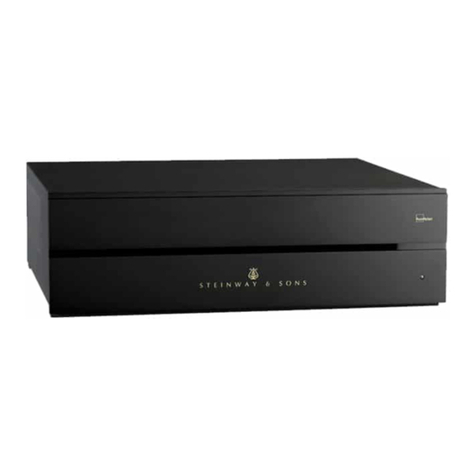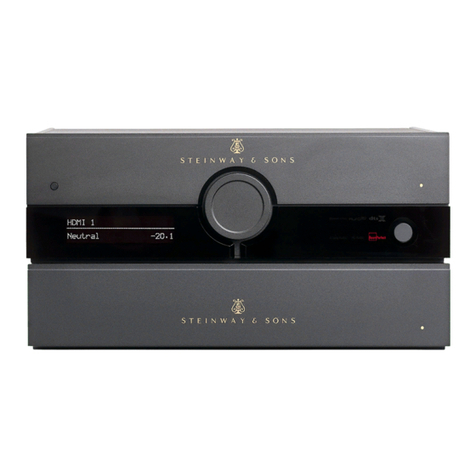STEINWAY LYNGDORF Steinway & Sons P300 User manual

[Skriv tekst]
PRELIMINARY INSTALLATION MANUAL
MODEL P300
Version 0.1/fsm
Steinway & Sons P300
OWNER’S
MANUAL
Version 1.0

Steinway & Sons P300 Owner’s manual
2
Table of Contents
Compliance .......................................................................................................... 4
Pre-Installation ..................................................................................................... 5
Unpacking the Product ..................................................................................... 5
Operating Voltage ............................................................................................ 5
Ventilation Requirements ................................................................................. 6
Heat output ....................................................................................................... 6
Home Automation System Integration ................................................................. 7
Preparing for Mounting in a Rack ........................................................................ 7
Rear Panel ........................................................................................................... 8
Remote ................................................................................................................ 9
How to Pair Remote ....................................................................................... 10
Switching Remote to RF and IR Mode ........................................................... 10
Setup Procedure ................................................................................................ 11
Installation Via OSD ........................................................................................... 12
Installation Via Web Interface ............................................................................ 12
Source ................................................................................................................ 13
Create ............................................................................................................. 13
Edit ................................................................................................................. 14
Arrange ........................................................................................................... 14
Delete ............................................................................................................. 14
Speaker and Room ............................................................................................ 15
Speaker Configuration .................................................................................... 15
RoomPerfect™ ............................................................................................... 15
How to Set Up RoomPerfect™ .......................................................................... 17
Volume Setting ............................................................................................... 17
RoomPerfect™ Preparations ......................................................................... 17
Placing the Microphone in the Focus Position ............................................... 17
Measuring the Focus Position ........................................................................ 18
Measuring Random Room Positions .............................................................. 18

Steinway & Sons P300 Owner’s manual
3
Room Measurements Above 90% RoomKnowledgeFejl! Bogmærke er ikke defineret.
Video Setup ....................................................................................................... 20
Video Output .................................................................................................. 20
Video Input ..................................................................................................... 20
Audio Setup ....................................................................................................... 21
Audio Processing ........................................................................................... 21
Voicing Setup ................................................................................................. 21
Zone B ............................................................................................................... 21
Setup .............................................................................................................. 21
System Configuration ......................................................................................... 22
General Setup ................................................................................................ 22
Trigger In Setup .............................................................................................. 23
Trigger Out Setup ........................................................................................... 23
Network Configuration .................................................................................... 23
Streaming Setup ............................................................................................. 23
Manage Software ............................................................................................... 24
Software Information ...................................................................................... 24
Network Information ....................................................................................... 24
Backup ........................................................................................................... 24
Restore ........................................................................................................... 24
Factory Reset ................................................................................................. 24
Software Update ............................................................................................. 24
Troubleshooting ................................................................................................. 26
RoomPerfect™ ............................................................................................... 26
Network Setup ................................................................................................... 28
Connecting to Model P300 with a Network Cable .......................................... 28
Set Up a Fixed IP Address in Windows XP or Windows 7 ............................. 29
Trademarks ........................................................................................................ 31
Service Information ............................................................................................ 32

Steinway & Sons P300 Owner’s manual
4
Compliance
WEEE
The European Parliament and the Council of the European Union have issued the Waste Electrical
and Electronic Equipment Directive. The purpose of the Directive is to prevent waste of electrical and
electronic equipment and to promote reuse, recycling, and other forms of waste recovery. Steinway
Lyngdorf products and the accessories packed with them are subject to the WEEE Directive. Please
dispose of any waste materials in accordance with your local recycling regulations. Products and
equipment which must be collected for reuse, recycling, and other forms of recovery are marked with
the icon of the crossed-out waste receptacle.
FCC
Steinway Lyngdorf products and accessories comply with parts 15 and 68 of the FCC rules.
Operation is subject to the following two conditions: (1) this device may not cause harmful
interference; and (2) this device must accept any interference received, including any interference
that may cause undesired operation. Model A1/A2 amplifier and Model P300 processor contain TX
FCC ID: TYOJN5139M0.
Changes or modifications not expressly approved by the party responsible for compliance could void
the user’s authority to operate the equipment. Equipment marketed to a consumer must be capable
of complying with the necessary regulations in the configuration in which the equipment is marketed.

Steinway & Sons P300 Owner’s manual
5
Pre-Installation
Please read all material carefully prior to installation. If you need additional assistance, contact your
Steinway Lyngdorf representative or email [email protected].
Unpacking the Product
Carefully remove the unit and accessory kit from the carton and check for shipping damage. Contact
both the shipper and your Steinway Lyngdorf representative immediately if the unit bears any sign of
damage.
Note: Keep the shipping carton and all packing material for future use. If this unit is
shipped without the original packing, damage could occur and void the warranty.
Inventory
Check the list below to ensure that all necessary product components have been delivered. Report all
discrepancies to your Steinway Lyngdorf representative immediately.
• Power cord
• Link cable
• Remote
LED Signaling
Red: Standby / On
Orange: Switching on
Blinking: Updating software
Operating Voltage
Steinway Lyngdorf products must be connected to the mains power system only. The Model P300 will
automatically detect the voltage between 110-230v.
Table of contents
Other STEINWAY LYNGDORF Recording Equipment manuals

STEINWAY LYNGDORF
STEINWAY LYNGDORF D User manual

STEINWAY LYNGDORF
STEINWAY LYNGDORF P1 User manual

STEINWAY LYNGDORF
STEINWAY LYNGDORF P1 User manual

STEINWAY LYNGDORF
STEINWAY LYNGDORF P200 Use and maintenance manual

STEINWAY LYNGDORF
STEINWAY LYNGDORF P300 2.1 User manual

STEINWAY LYNGDORF
STEINWAY LYNGDORF P200 User manual

















